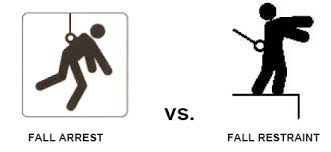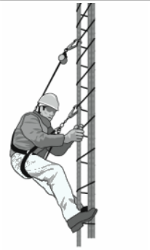Personal fall protection system means a system (including all components) used to provide protection from falling or to safely arrest an employee's fall if one occurs. Personal fall restraint and arrest systems and positioning devices are considered personal protective equipment.
Fall Protection Systems Hierarchy
Fall protection systems are intended to prevent employees from falling off, onto or through working levels. The rules for construction work are slightly different from general industry and university work, but both have the same fall protection hierarchy:
- Guard rails and other engineering controls
- Fall restraint
- Fall arrest
See the EH&S main Fall Protection web page for more information on guard rails and other fall protection controls.
Quick Links
SFSU Fall Protection web page (link is pending)
SFSU Personal Protective Equipment web page
Fall Arrest and Restraint Systems
Fall Restraint
A fall restraint system is one that will allow the person to work at a leading edge while preventing the worker from reaching the edge and falling off. This type of restraint system is often compared to a leash. It restricts movement to prevent the person from traveling beyond the edge. This is the preferred person fall protection system.
Fall Arrest
A fall arrest system does not prevent a person from reaching the edge and falling off. Instead, it protects after the fall, by preventing you from colliding with the ground or structures and limiting the forces on the body. There is still high risk of injury using fall arrest systems from the forces exerted on the body. Components of a personal fall arresting system include a body harness, lanyard, lifeline, connector, and an anchorage point capable of supporting at least 5000 pounds.
- Always use full-body harnesses, never belts, when employing fall arrest systems.
- Limit maximum arresting force on a worker to 1,800 lbs. when using a body harness.
- Fall arrest system must be rigged so a worker can neither free fall more than 4 feet), nor contact any lower level. Deceleration devices (shock-absorbing lanyard) used must not exceed 3.5 feet.

Positioning Device Systems
Positioning device systems consist of a body belt or harness rigged to allow work on a vertical surface, such as a wall, with both hands free.
Image source: Princeton University
